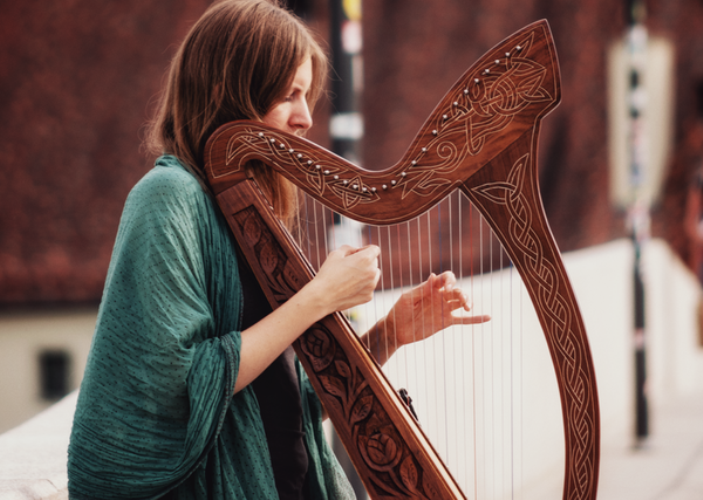
All harps have a neck, resonator, and strings, frame harps or triangular harps have a pillar at their long end to support the strings, while open harps, such as arch harps and bow harps, do not. COURTESY
The harp is a stringed musical instrument that has a number of individual strings running at an angle to its soundboard; the strings are plucked with the fingers. Harps can be made and played in various ways, including standing or sitting and in orchestras or concerts. Its most common form is triangular in shape and made of wood. Some have multiple rows of strings and pedal attachments.
Ancient depictions of harps were recorded in current day Iraq, Iran and Egypt and later in Pakistan, India and China. By medieval times harps had spread across Europe. Harps were found across the Americas where it was a popular folk tradition in some areas. Distinct designs also emerged from the African continent. Harps have symbolic political traditions and are often used in logos, including in Ireland.
Therapeutic harpists use the intrinsic healing elements of live music and sound to synchronize a patient's physiological rhythms to the harp music and provide an environment conducive to the healing process.
Harps have been known since antiquity in Asia, Africa and Europe, dating back at least as early as 3000 BCE. The instrument had great popularity in Europe during the Middle Ages and Renaissance, where it evolved into a wide range of variants with new technologies, and was disseminated to Europe's colonies, finding particular popularity in Latin America.
Although some ancient members of the harp family died out in the Near East and South Asia, descendants of early harps are still played in Myanmar and parts of Africa; other variants defunct in Europe and Asia have been used by folk musicians in the modern era.
Harps vary globally in many ways. In terms of size, many smaller harps can be played on the lap, whereas larger harps are quite heavy and rest on the floor. Different harps may use strings of catgut, nylon, metal, or some combination.
All harps have a neck, resonator, and strings, frame harps or triangular harps have a pillar at their long end to support the strings, while open harps, such as arch harps and bow harps, do not.
Modern harps also vary in techniques used to extend the range and chromaticism of the strings (e.g., adding sharps and flats). On lever harps one adjusts a string's note mid-performance by flipping a lever, which shortens the string enough to raise the pitch by a chromatic sharp. On pedal harps depressing the pedal one step turns geared levers on the strings for all octaves of a single pitch; most allow a second step that turns a second set of levers. The pedal harp is a standard instrument in the orchestra of the Romantic music era (ca. 1800–1910 CE) and the 20th and 21st century music era.
Harps are essentially triangular and made primarily of wood. Strings are made of gut or wire, often replaced in the modern day by nylon or metal. The top end of each string is secured on the crossbar or neck, where each will have a tuning peg or similar device to adjust the pitch. From the crossbar, the string runs down to the sounding board on the resonating body, where it is secured with a knot; on modern harps the string's hole is protected with an eyelet to limit wear on the wood. The distance between the tuning peg and the soundboard, as well as tension and weight of the string, determine the pitch of the string. The body is hollow, and when a taut string is plucked, the body resonates, projecting sound.
The longest side of the harp is called the column or pillar (though some earlier harps, such as a "bow harp", lack a pillar). On most harps the sole purpose of the pillar is to hold up the neck against the great strain of the strings. On harps which have pedals (largely the modern concert harp), the pillar is a hollow column and encloses the rods which adjust the pitches, which are levered by pressing pedals at the base of the instrument.
On harps of earlier design, a single string produces only a single pitch unless it is retuned. In many cases this means such a harp can only play in one key at a time and must be retuned to play in another key. Harpers and luthiers have developed various remedies to this limitation:






0 Comments